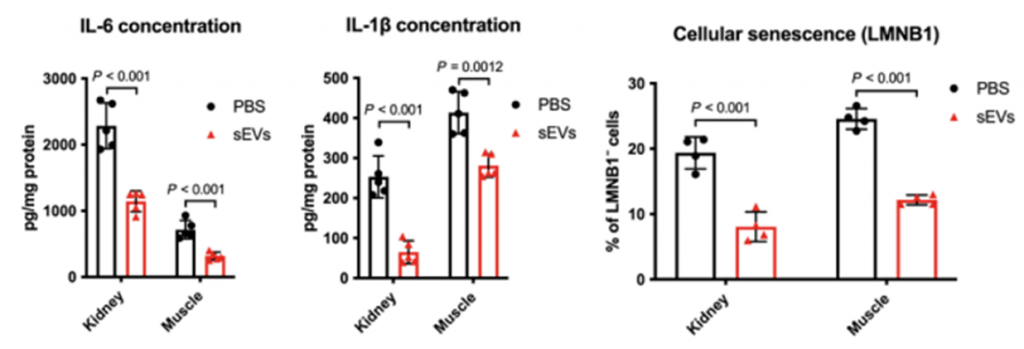Key Points:
- Treating old mice with young ADSC-sEVs improves physical function, reduces frailty, and restores hair regrowth capacity.
- ADSC-sEV treatment leads to pro-regenerative effects in the kidney and hinders muscle atrophy in aged mice.
- Treatment with young ADSC-sEVs attenuates inflammation and senescence.
Stem cells have continuously been touted as a promising aging intervention, as they hold self-renewal and anti-inflammatory properties that contribute to organ rejuvenation and immune system regulation. However, stem cell therapy requires some refinement before it can be widely used. Recently, scientists have honed in on small fat packets secreted from stem cells known as small extracellular vesicles (sEVs), which carry molecules that hold similar pro-regenerative properties and carry a lower risk of immune rejection upon transplantation.
In a new study published in the journal Science Advances, researchers from the University of Valencia explore the effects of sEVs derived from cultured adipose mesenchymal stem cells (ADSCs) of young animals. Sanz-Ros and colleagues found that treating aged mice with young ADSC-sEVs boosts physical function, reduces frailty, and promotes fur regeneration. Furthermore, the treatment led to pro-regenerative effects in the kidneys and muscles of aged mice, restoring the structural changes that occur with aging. Notably, inflammation and senescence, two hallmarks of aging, are significantly reduced in the kidneys and muscles of aged mice following treatment.
ADSC-sEVs Reduce Frailty and Drive Tissue Regeneration
Aging inevitably compromises our muscles and bones, making us weak and frailer as we age. Ameliorating physical impairment is vital to longevity; thus, the investigators examined whether treating aged mice with young ADSC-sEVs could restore physical function. Aged mice received one injection of ADSC-sEVs in the tail vein. The results showed that treated mice displayed significantly stronger grip strength than untreated mice. Additionally, 40% of untreated mice exhibited frailty, while 0% of the treated mice exhibited frailty, demonstrating that young ADSC-sEVs improve the healthspan of aged mice.
Another feature associated with aging is hair loss and the inability to regrow hair. Given that only two FDA-approved drugs exist for hair loss, with results varying between individuals, the need for novel hair loss interventions is of the utmost importance. Sanz-Ros and colleagues showed that treating aged mice with young ADSC-sEVs significantly promoted fur regeneration, highlighting the potential of ADSC-sEVs as a future therapy for hair loss.

The University of Valencia researchers proceeded to analyze the pro-regenerative effects of ADSC-sEVs in the kidneys and muscles of aged mice. Accordingly, the investigators monitored structural changes indicative of aging and examined whether treatment could reverse these changes. A marker for kidney dysfunction is decreased tubular density, and the investigators found that untreated aged mice had much lower tubular density than treated aged mice. What’s more, they showed that treatment promoted more significant cell growth, demonstrating the pro-regenerative role of ADSC-sEVs in the kidneys of aged mice.
The size of muscle fibers gradually declines with age, hindering our ability to accomplish normal day-to-day tasks. As expected, untreated aged mice exhibited smaller muscle fibers than treated aged mice. Furthermore, treatment restored the amount of fast type II fibers, which, when absent, characterize sarcopenia, a deadly disease characterized by muscle mass and strength loss. Overall, the findings suggest that young ADSC-sEVs hold pro-regenerative capabilities that could potentially boost healthspan and delay aging features.

ADSC-sEVs Regulate Inflammation and Senescence
Increased senescent cell accumulation has strong ties to the development of many age-related diseases, including cancer and neurodegeneration. As senescent cells sprout throughout the body upon aging, they release harmful molecules called the senescence-associated secretory phenotype (SASP), which trigger chronic systemic inflammation and further drive the aging process.
With this in mind, Sanz-Ros and colleagues looked at two SASP markers (IL-6 and IL-1B) linked to inflammation in the kidneys and muscles of aged mice following treatment. The investigators also examined a marker (LMNB1) of cellular senescence. The results showed that treatment led to lower levels of IL-6, IL,1B, and LMNB1, indicating that young ADSC-sEVs effectively suppress the SASP and limit senescent cell burden.

Stem Cell-Derived sEVs and Aging
The intricate nature of aging has made the search for potent and comprehensive longevity interventions quite difficult. That being said, new therapies like stem cell-derived sEVs show great potential in targeting the aging process. In addition to holding powerful regenerative properties that have been shown to assist with tissue regeneration after damage, stem cell-derived sEVs have been shown to extend lifespan in a mouse model of accelerated aging. Another study found that these sEVs mitigate senescence-related tissue damage and ameliorate oxidative stress by increasing the activity of glutathione, the most potent anti-oxidant in our bodies. Now, with the current study showing that stem cell-derived sEVs attenuate frailty, lower inflammation, and limit senescence, it’s clear that these small particles may play a vital role in the fight against aging in the future.